Summer bugs: friends or foes?
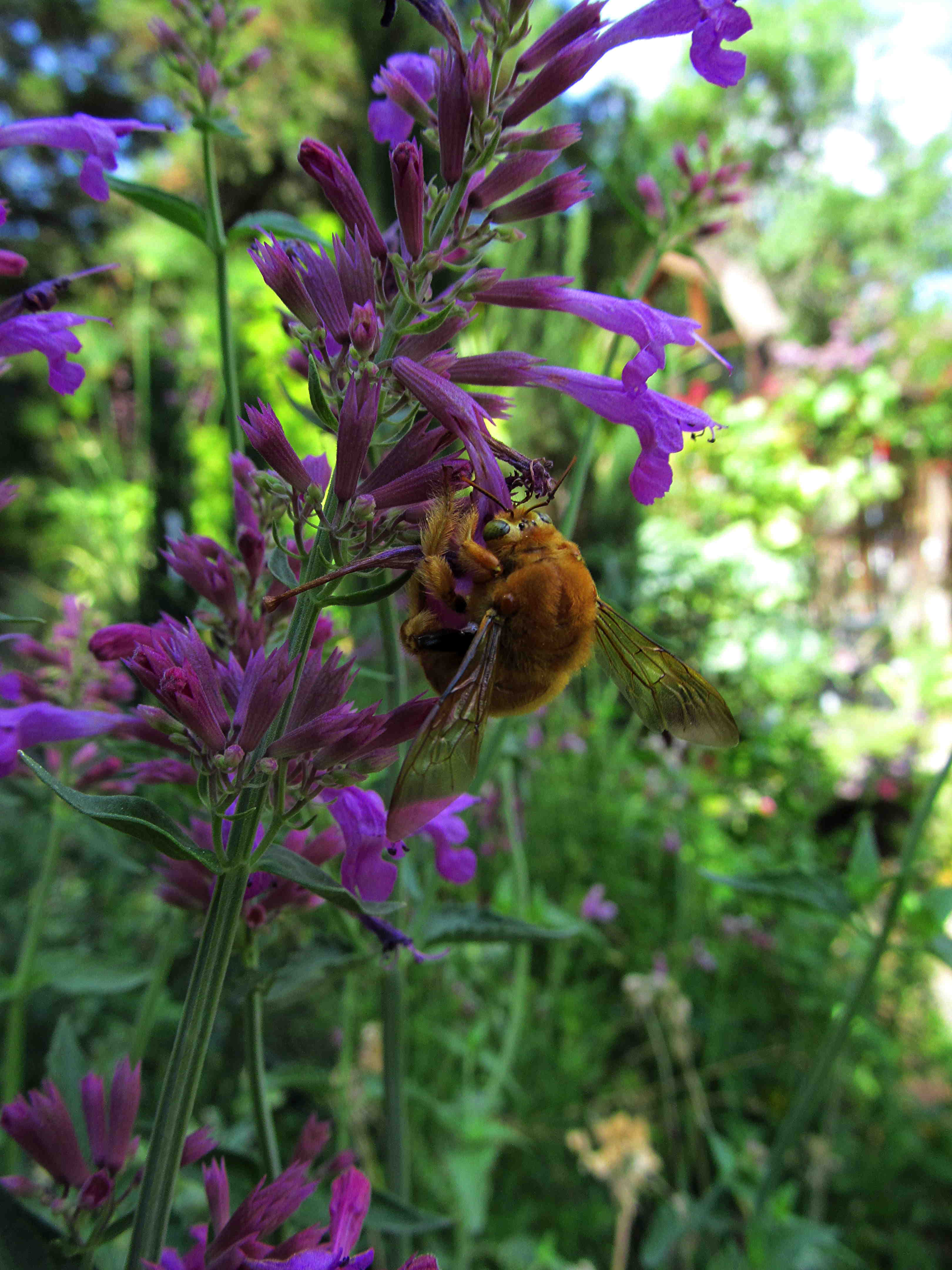 A two-inch long bee? Fuzzy, blonde-brown, and rather docile, the male carpenter bee is startlingly large, but not aggressive. Carpenter bees are native pollinators attracted to lots of different flowers, especially penstemons and salvias.
A two-inch long bee? Fuzzy, blonde-brown, and rather docile, the male carpenter bee is startlingly large, but not aggressive. Carpenter bees are native pollinators attracted to lots of different flowers, especially penstemons and salvias.
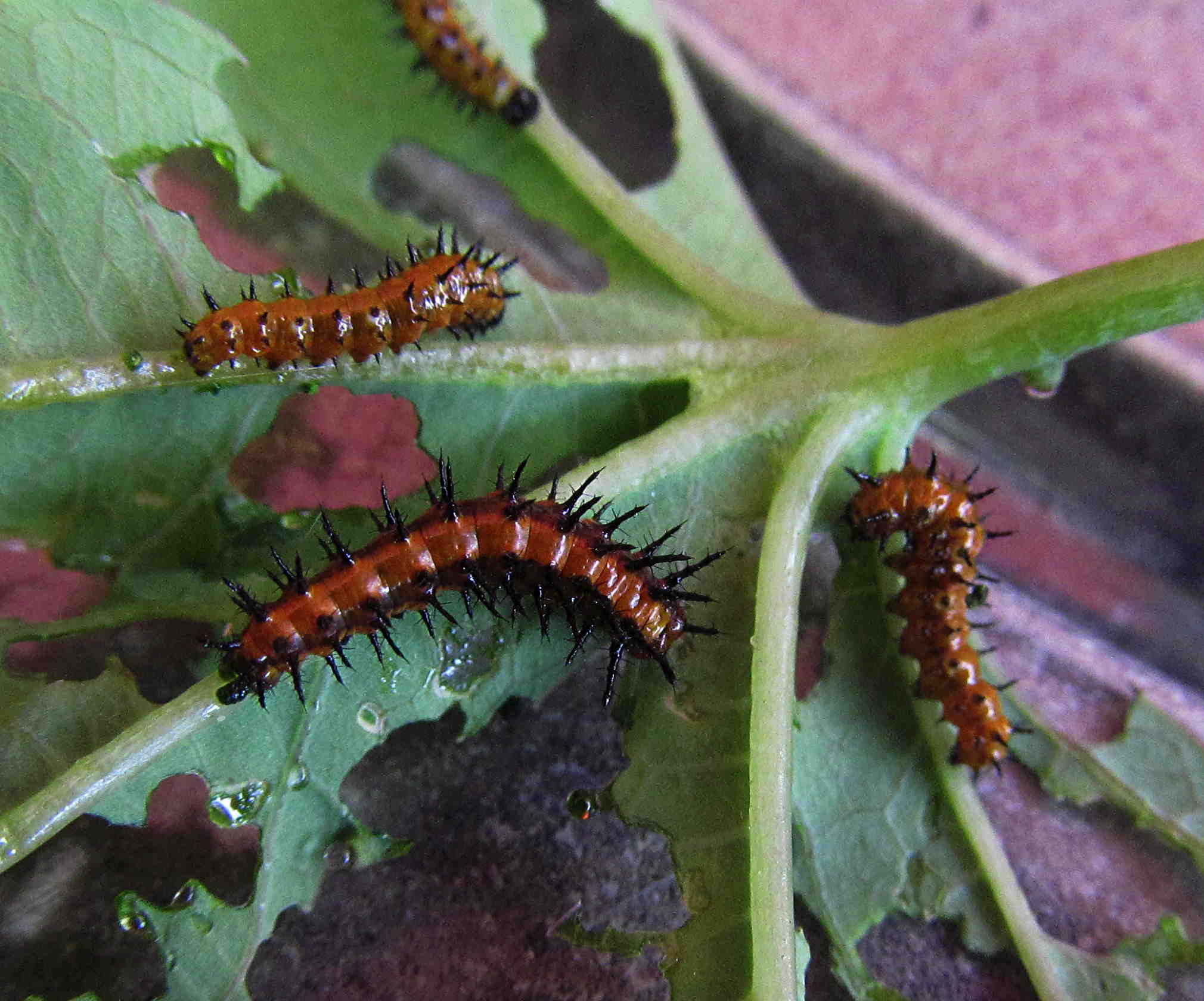 If you want the beautiful butterflies, you'll have to accept the caterpillars! Larvae of the gulf fritillary butterfly eat a lot of passionflower foliage, but the plants are vigorous and outgrow the problem. There are organic sprays for caterpillars if they are doing more damage than you can tolerate.
If you want the beautiful butterflies, you'll have to accept the caterpillars! Larvae of the gulf fritillary butterfly eat a lot of passionflower foliage, but the plants are vigorous and outgrow the problem. There are organic sprays for caterpillars if they are doing more damage than you can tolerate.
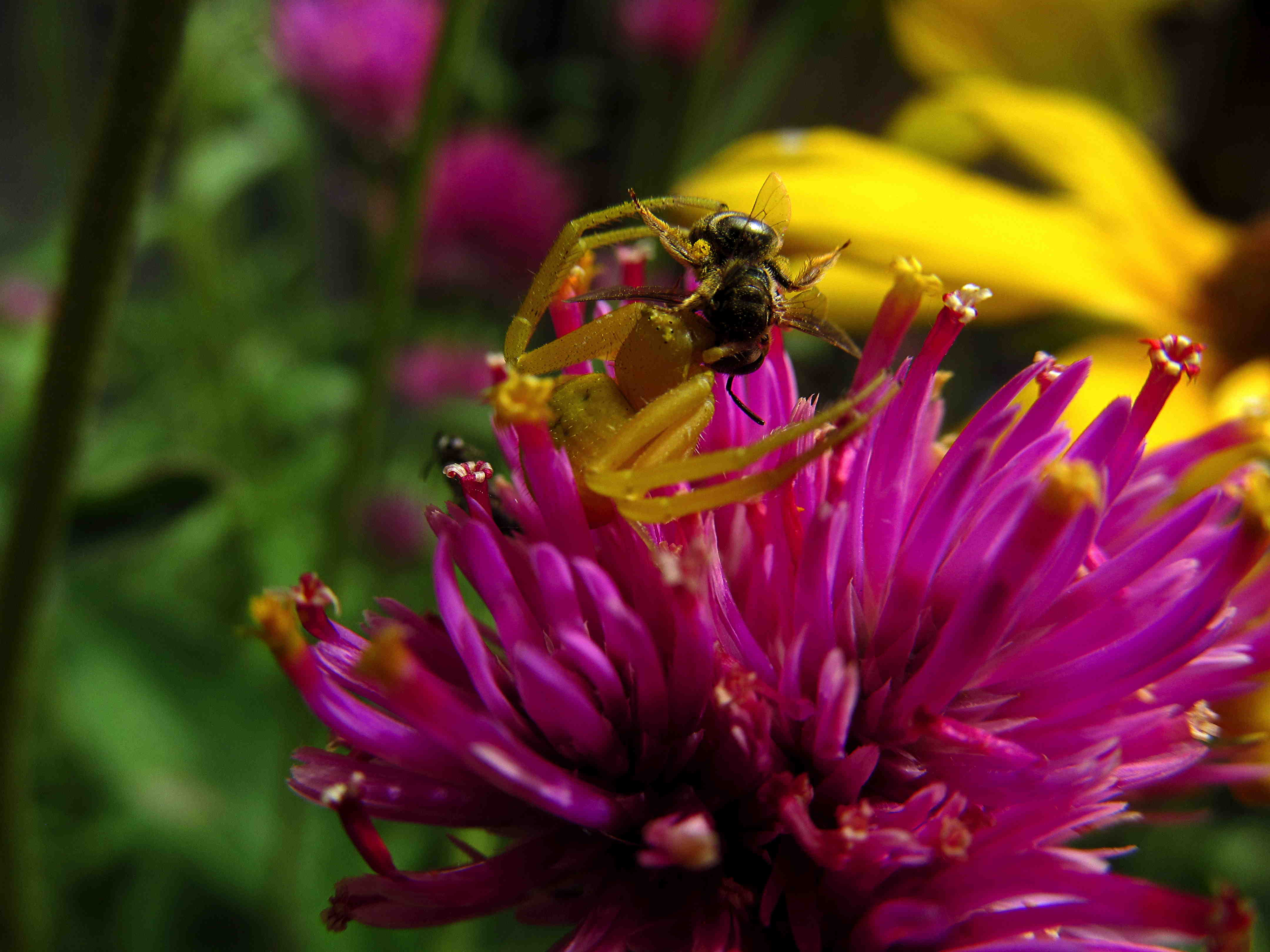 Spiders are good guys. Well, mostly. Here a crab spider has caught a small native bee. Spiders are general feeders, eating pests and other insects, and sometimes each other.
Spiders are good guys. Well, mostly. Here a crab spider has caught a small native bee. Spiders are general feeders, eating pests and other insects, and sometimes each other.
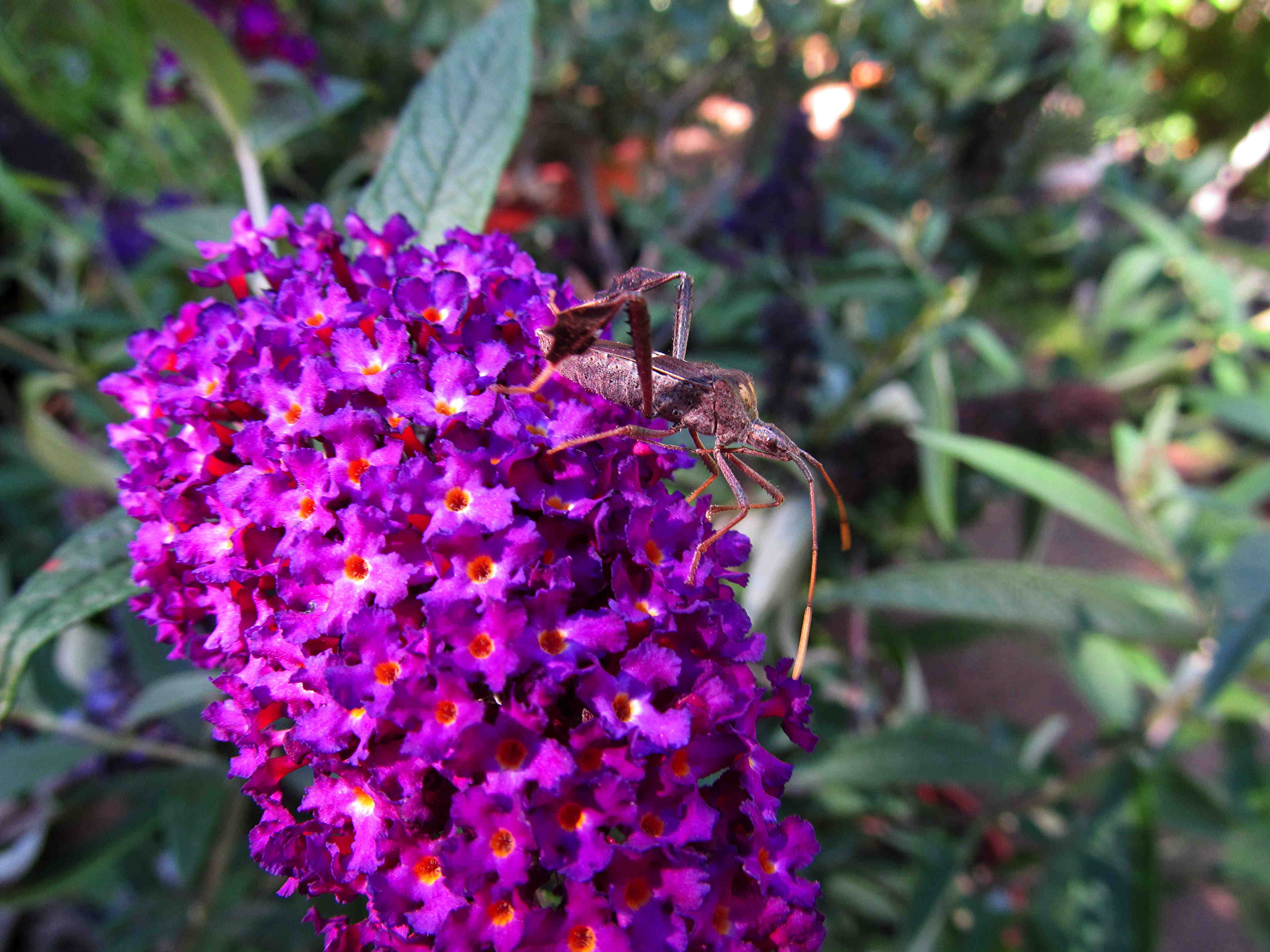 You'll find leaffooted bugs on tomato plants, garden flowers, and any number of fruit and nut trees. Sometimes their feeding blemishes and disfigures the fruit, but mostly they can be tolerated.
You'll find leaffooted bugs on tomato plants, garden flowers, and any number of fruit and nut trees. Sometimes their feeding blemishes and disfigures the fruit, but mostly they can be tolerated.
 A new perennial! Using traditional hybridization (not genetic engineering), Digitalis was crossed with Isoplexis. The result? Digiplexis, which produces spikes of flowers all summer long. Probably wants partial shade in the Valley.
A new perennial! Using traditional hybridization (not genetic engineering), Digitalis was crossed with Isoplexis. The result? Digiplexis, which produces spikes of flowers all summer long. Probably wants partial shade in the Valley.
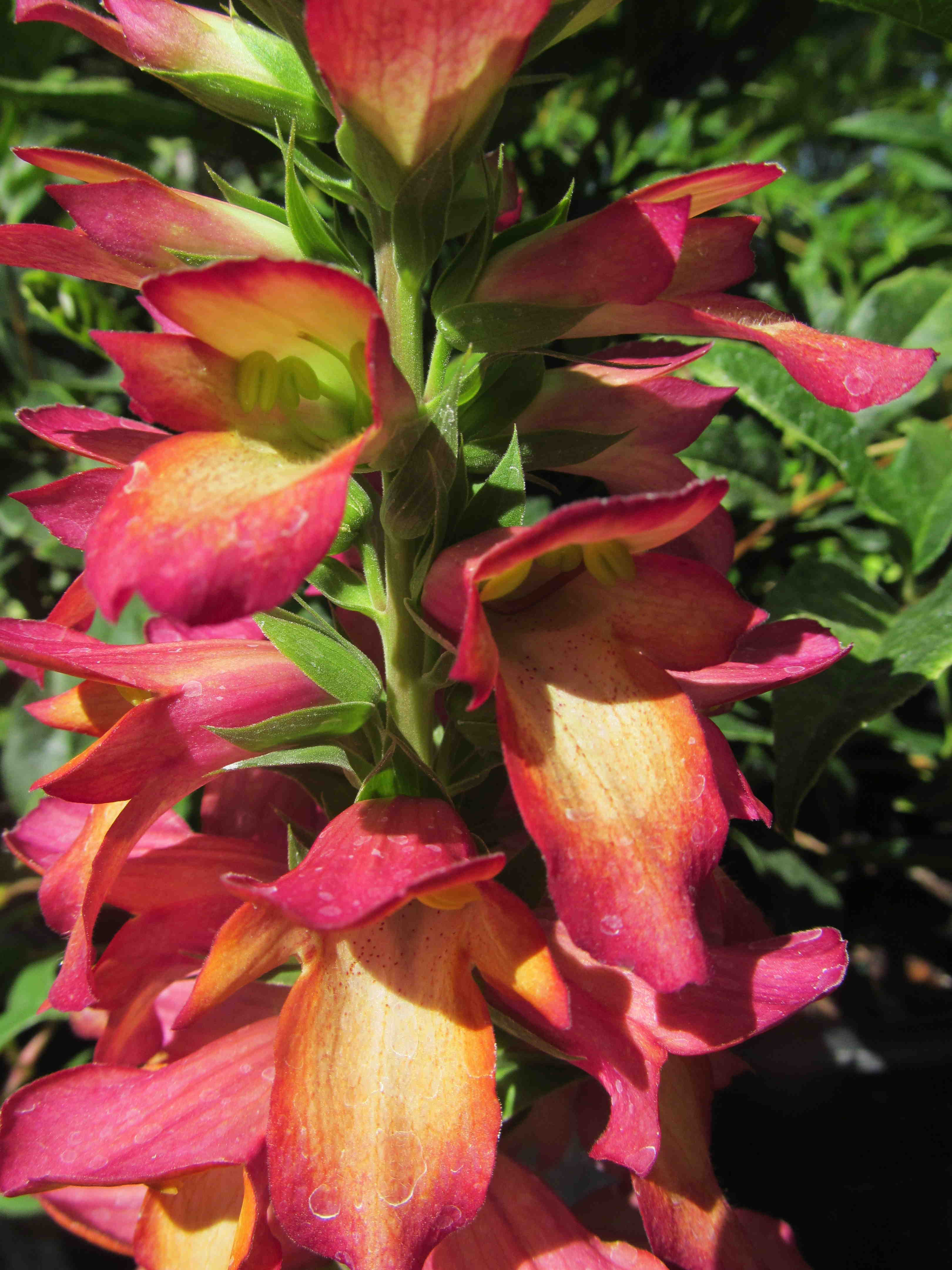 Closeup of Digiplexis flower.
Closeup of Digiplexis flower.
Some Summer Bugs: friends or foes?
Written for the Davis Enterprise August 7, 2014
The drone of orchard sprayers at sunrise reminded me that there is a downside to the unseasonably cool, damp weather we've been having. Fungus diseases
require high moisture to inoculate and establish. Twice in the last month we've had 2 to 3-day intervals of overcast with light sprinkles.
Expect disease problems, ranging from powdery mildew on crapemyrtle and cucumber to blight on sycamores, to show up in about seven to ten days. I imagine
wine grape growers are worried. And in your garden, soft-bodied insects such as aphids and whiteflies may show population increases due to the mild
weather.
Usually by summertime, beneficial insects that control garden pests have increased, keeping the pest populations at acceptable levels. High temperatures
and low humidity slow the reproductive rate of the aphids. Expect a little surge in those populations. A return to hot, dry weather will ordinarily put a
stop to the spread of any disease or pest outbreak.
Which brings us to this week's related question about summer pests: West Nile spraying.
They're spraying around Davis for mosquitoes due to West Nile virus. What will that do to my garden?
From a press release reported in the Enterprise Aug. 5:
... the Sacramento-Yolo Mosquito & Vector Control District has scheduled aerial spraying of a low-toxicity insecticide over Davis and Woodland this week.
The insecticide Trumpet will be dispersed at ultra-low volumes over the cities."
Spraying was set to occur Wed. Aug. 6 and Thursday Aug. 7 in the evening, weather permitting.
I have anecdotal reports from gardeners around Sacramento where spraying has occurred about sudden increases in aphid and whitefly populations shortly
afterwards. This makes sense. The material being applied doesn't kill mosquitoes selectively. We would expect some harm to populations of beneficial
insects, particularly small ones such as the parasitic wasps that help keep aphids in check. From studies I have seen, larger insects such as dragonflies,
honeybees, spiders, and butterflies are not affected. The dosage is low, and the spraying is done at night when those aren't active.
Doesn't the spray kill aphids, too?
Probably, at least some of them. But their reproductive rate means their populations will rebound faster. Good news: the beneficial insects will catch up
and restore the equilibrium within a couple of weeks.
Should I spray the aphids and whiteflies?
That would likely kill the good guys too, and keep them from coming back. Manage aphid and whitefly problems by vigorously rinsing with water. Blast the
plant, especially on the undersides of the leaves, early each day for 3 to 4 mornings in a row. You'll wash off young aphids, eggs and larvae of
whiteflies, and spider mites. Beneficial insects won't be harmed.
But my garden is organic.
Unfortunately, the spray material they are using is not organic. But according to the label, it washes off.
Other bugs in the summer garden.
What is this giant bee?!? It's about two inches long, fuzzy, golden!
This giant, fuzzy, charming, friendly creature is the male of the carpenter bee. Stingless, harmless, and short-lived, it always startles people when they
encounter it during early summer. Carpenter bees are pretty good pollinators, attracted to a range of flowers but especially to tubular ones such as
penstemons and salvias.
There are caterpillars eating my passionflower vine!
Last month's column was about drawing beneficial pollinators to the garden. One way to do that is to plant larval food sources. In the case of the Gulf
fritillary butterfly, the larvae feed exclusively on Passiflora species: passionflower vines. So if you want the butterflies, you need to tolerate
the damage from the caterpillars.
Caterpillars of many moth and butterfly species can do a lot of damage in a short time. They need to eat huge amounts of leaf material as they grow quickly
before they pupate.
The good news is that this is a fairly short stage, and most plants can quickly outgrow the leaf damage, so control measures aren't really warranted. By
the time you notice the defoliation, they're nearly done. And birds can do a pretty good job of reducing the population numbers.
If the problem is severe, you can spray with the organic products that contain BT. They kill caterpillars only, and work best when the caterpillars are
still young.
Do you have a spray for spiders? They're all over the place. Do they do any good in the garden?
Don't spray for spiders. A good spider population is a sign of a healthy garden. They are beneficial in the sense that they eat pest insects. They are
general feeders, so they also eat beneficial insects, and each other. The common spiders that you see in your garden are not aggressive or harmful.
Orb-weavers spin the beautiful webs that stretch across garden paths. Just take a stick and relocate the corner of the web to move them out of the way.
Note how she scrambles in the other direction as you do so. Crab spiders lay in wait in flowers to catch unsuspecting flying insects. Shake off flowers
before you bring them into the house. These are just a couple of the types of spiders helping to maintain the balance of nature in your garden.
We do have black widow spiders here, and they are well known for their venomous bite. They are surprisingly common, yet the bites are rare. That is because
they like dark places, don't like to be disturbed, and will typically scramble further into the darkness if you expose them to sunlight.
Wear gloves when moving firewood, cleaning up debris piles, or rummaging deep into garden sheds. Sprays are really not effective for spiders. Just know
their habitat and cover your skin when you are invading their spaces.
Contrary to popular belief and current Internet memes, we do not have brown recluse spiders here.
I found these giant bugs on my pomegranate tree. Do they do any harm?
Leaf-footed bugs (Leptoglossus) seem to be in high numbers this year. Their population fluctuates, so this may be related to drought, late spring rains, or
winter weather. The name refers to flat leaf-like protrusions on the hind legs, or what entomologists call "foliaceous hind tibiae." It is considered a
minor pest of nut and fruit crops; gardeners mostly find them on tomatoes and pomegranates. These are among the bugs that cause misshapen and blemished
peaches, nectarines, and tomatoes from their early-season feeding as the fruit is developing.
The fruit is usable. Damage to mature tomatoes is minimal (you probably won't even notice it). Their strong mouthparts can penetrate pomegranate skin and
suck the juices of a few of the little arils, but most of the fruit is unaffected.
Management involves removing overwintering weeds (especially thistles) and cover crops by mowing before fruit sets on your nearby trees. They overwinter
inside unpicked pomegranates that hang on the tree or rot on the ground during winter. Maintaining a clean orchard floor is a basic principle of disease
and pest management in fruit orchards, and a good idea for home gardeners as well. The old reliable pick-and-stomp technique also works.
A quick change of subject: new plants!
In our industry we are bombarded with promotions of exciting 'new' varieties of flowers. We get a little jaded: how many petunia hybrids do we really need?
So when something genuinely new comes along, it creates a buzz among gardeners and plant professionals.
Plant breeders crossed Digitalis (foxglove) with a related shrub named Isoplexis. This yielded Digi-plexis, a bushy plant with foxglove-like spikes of
flowers over a very long season, May until frost by most accounts. From the shrub parent we get basal branching and a nice full habit. The color is unique,
a sort of coppery-pink.
Where to plant them? Our best guess for the Valley is partial shade or morning sun. Not fussy as to soil. Regular watering. A new perennial for Davis
gardens!
© 2014 Don Shor, Redwood Barn Nursery, Inc., 1607 Fifth Street, Davis, Ca 95616
www.redwoodbarn.com
Feel free to copy and distribute this article with attribution to this author.
Click here for Don's other Davis Enterprise articles
